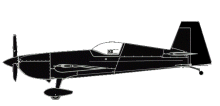
ASN Wikibase Occurrence # 170595
This information is added by users of ASN. Neither ASN nor the Flight Safety Foundation are responsible for the completeness or correctness of this information.
If you feel this information is incomplete or incorrect, you can submit corrected information.
| Date: | Monday 11 August 2003 |
| Time: | 17:18 LT |
| Type: |  Extra EA-300 |
| Owner/operator: | Royal Jordanian Falcons |
| Registration: | JY-RNG |
| MSN: | 065 |
| Fatalities: | Fatalities: 0 / Occupants: 1 |
| Aircraft damage: | Minor |
| Location: | Shoreham Airport, Cecil Pashley Way, Shoreham-by-Sea, West Sussex -
 United Kingdom United Kingdom
|
| Phase: | Landing |
| Nature: | Private |
| Departure airport: | Reims–Champagne AB (RHE/LFSR) |
| Shoreham, West Sussex (EGKA) | |
| Investigating agency: | AAIB |
| Confidence Rating: |
Collided with Extra 300 JY-RNL (066) on landing at Shoreham Airport, Cecil Pashley Way, Shoreham-by-Sea, West Sussex. Both aircraft were two of the four aircraft of the "Royal Jordanian Falcons" aerobatic display team. According to the follwing excerpt from the official AAIB report into the accident:
"The two aircraft involved in the collision formed part of a four ship display team. The team departed Reims Airport, France, together, and on arrival at Shoreham positioned into the circuit downwind for Runway 21. Weather conditions were good with light winds and visibility of 7,000 metres.
Runway 21 has a paved surface with a landing distance available of 865 metres and a width of 18 metres. At the upwind end of the runway there are two paved taxiway exits, the first exit leads directly to the ramp area and the second, at the runway end, turns back parallel to the runway before joining the main taxiway.
The Number Two aircraft landed, decelerated to taxi speed and saw that the leader had exited at the end of the runway. He decided to follow and vacate at the end also. As he was doing so he felt a shock and a push forward and, taking a quick look back, he realised that he had been hit by the aircraft behind.
The Number Three aircraft landed behind the Number Two and decelerated to taxi speed. He thought that the Number Two was exiting the runway at the first taxiway and did not realise that it was actually continuing to the end of the runway. Because of the limited field of view from his own aircraft he did not see that the other aircraft was still on the runway. As he continued to taxi his propeller hit the rudder and horizontal stabiliser of the aircraft ahead. When he realised there had been contact he shut the engine down and both crew vacated the aircraft."
Accident investigation:
 |
|
Sources:
1. https://assets.publishing.service.gov.uk/media/5422f9e840f0b61346000801/dft_avsafety_pdf_024591.pdf
Revision history:
| Date/time | Contributor | Updates |
|---|---|---|
| 23-Oct-2014 17:38 | Alpine Flight | Added |
| 02-Dec-2014 23:01 | Dr. John Smith | Updated [Departure airport, Destination airport, Embed code, Narrative] |
| 02-Dec-2015 18:25 | TB | Updated [Location, Departure airport, Narrative] |
| 02-Dec-2015 18:27 | TB | Updated [Location] |
| 28-Jul-2016 13:56 | Dr.John Smith | Updated [Location, Source, Narrative] |
Corrections or additions? ... Edit this accident description
The Aviation Safety Network is an exclusive service provided by:


 ©2024 Flight Safety Foundation
©2024 Flight Safety Foundation